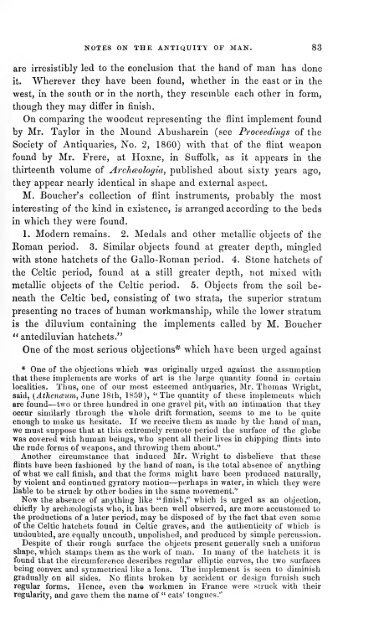The anthropological review - National Library of Scotland
The anthropological review - National Library of Scotland
The anthropological review - National Library of Scotland
Create successful ePaper yourself
Turn your PDF publications into a flip-book with our unique Google optimized e-Paper software.
NOTES ON THE ANTIQUITY OF MAN. 83<br />
are irresistibly led to the conclusion that the hand <strong>of</strong> man has done<br />
it. Wherever they have been found, whether in the east or in the<br />
west, in the south or in the north, they resemble each other in form,<br />
though they may differ in finish.<br />
On comparing the woodcut representing the flint implement found<br />
by Mr. Taylor in the Mound Abusharein (see Proceedings <strong>of</strong> the<br />
Society <strong>of</strong> Antiquaries, No. 2, 1860) with that <strong>of</strong> the flint weapon<br />
found by Mr. Frere, at Hoxne, in Suffolk, as it appears in the<br />
thirteenth volume <strong>of</strong> Archaologia, published about sixty years ago,<br />
they appear nearly identical in shape and external aspect.<br />
M. Boucher's collection <strong>of</strong> flint instruments, probably the most<br />
interesting <strong>of</strong> the kind in existence, is arranged according to the beds<br />
in which they were found.<br />
1, Modern remains. 2. Medals and other metallic objects <strong>of</strong> the<br />
Roman period. 3. Similar objects found at greater depth, mingled<br />
with stone hatchets <strong>of</strong> the Gallo-Roman period. 4. Stone hatchets <strong>of</strong><br />
the Celtic period, found at a still greater depth, not mixed with<br />
metallic objects <strong>of</strong> the Celtic period. 5. Objects from the soil be-<br />
neath the Celtic bed, consisting <strong>of</strong> two strata, the superior stratum<br />
presenting no traces <strong>of</strong> human workmanship, while the lower stratum<br />
is the diluvium containing the implements called by M. Boucher<br />
" antediluvian hatchets."<br />
One <strong>of</strong> the most serious objections*' which have been urged against<br />
* One <strong>of</strong> the objections which was originally urged against the assumption<br />
that these implements are works <strong>of</strong> art is the large quantity found in certain<br />
localities. Thus, one <strong>of</strong> our most esteemed antiquaries, Mr. Thomas "Wright,<br />
said, (^t/te?i(Ei(??t, June 18th, 1859), " <strong>The</strong> quantity <strong>of</strong> these implements which<br />
are found—two or three hundred in one gravel pit, with an intimation that they<br />
occur similarly through the whole drift formation, seems to me to be quite<br />
enough to make us hesitate. If we receive them as made by the hand <strong>of</strong> man,<br />
we must suppose that at this extremely remote period the surface <strong>of</strong> the globe<br />
was covered with human beings, who spent all their lives in chipping flints into<br />
the rude forms <strong>of</strong> weapons, and throwing them about."<br />
Another circumstance that induced Mr. Wright to disbelieve that these<br />
flints have been fashioned by the hand <strong>of</strong> man, is the total absence <strong>of</strong> anything<br />
<strong>of</strong> what we call finish, and that the forms might have been produced naturally,<br />
by violent and continued gyratory motion— perhaps in water, in which they were<br />
liable to be struck by other bodies in the same movement."<br />
Now the absence <strong>of</strong> anything like "finish," which is urged as an objection,<br />
chiefly by archieologists who, it has been well observed, are more accustomed to<br />
the productions <strong>of</strong> a later period, may be disposed <strong>of</strong> by the fact that even some<br />
<strong>of</strong> the Celtic hatchets found in Celtic graves, and the authenticity <strong>of</strong> which is<br />
undoubted, are equally uncouth, unpolished, and produced by simple percussion.<br />
Despite <strong>of</strong> their rougli surface the objects present generally such a uniform<br />
shape, which stamps them as the work <strong>of</strong> man. In many <strong>of</strong> the hatchets it is<br />
found that the circumference describes regular elliptic curves, the two surfaces<br />
being convex and symmetrical like a lens. <strong>The</strong> implement is seen to diminish<br />
gradually on all sides. No flints broken by accident or design furnish such<br />
regular forms. Hence, even the workmen in France were struck with their<br />
regularity, and gave them the name <strong>of</strong> " cats' tongues."

















